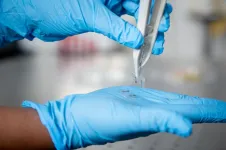(Press-News.org) CHICAGO - A new study shows that youth arrested as juveniles with psychiatric disorders that remain untreated, struggle with mental health and successful outcomes well beyond adolescence.
Research from Northwestern Medicine shows nearly two-thirds of males and more than one-third of females with one or more existing psychiatric disorders when they entered detention, still had a disorder 15 years later.
The findings are significant because mental health struggles add to the existing racial, ethnic and economic disparities as well as academic challenges from missed school, making a successful transition to adulthood harder to attain.
"Kids get into trouble during adolescence.Those from wealthier families also use drugs and get into fights. But these situations are most often handled informally by the school and parent, and don't culminate in arrest and detention," said lead author Linda Teplin, Owen L. Coon Professor of psychiatry and behavioral sciences at Northwestern University Feinberg School of Medicine.
"These are not necessarily bad kids, but they have many strikes against them. Physical abuse, sexual abuse and neglect are common. These experiences can precipitate depression. Incarceration should be the last resort," said Teplin, also a faculty associate with the University's Institute for Policy Research.
The unprecedented longitudinal study reports on the prevalence, persistence and patterns of behavioral and psychiatric disorders in youth up to 15 years after they leave detention and whether outcomes vary by sex and race/ethnicity.
Key findings show that despite a decrease in disorders over time, especially among females, the prevalence of psychiatric disorders 15 years later was still substantially higher than the general population.
Males fared significantly worse overall. Among youth with a disorder in detention, 64.3% of males and 34.8% of females had one or more disorders 15 years later. Compared with females, males had more than three times the odds of persisting with a psychiatric disorder over time.
"This may be because females, as they age, became more family-focused. Positive social connections - having a stable partner, raising children, establishing a family - are conducive to positive mental health," said study co-author Karen Abram, professor of psychiatry and behavioral sciences at Feinberg School of Medicine and associate director of the Program in Health Disparities and Public Policy.
Fifteen years after youth left detention, disruptive behavior and substance abuse disorders were the most common. Non-Hispanic whites had 1.6 times greater odds of having behavioral disorders and more than 1.3 times greater odds of having substance use disorders throughout the follow-up period compared with African Americans and Hispanics.
"An unanticipated finding of the study was the lower rate of substance use disorders in racial/ethnic minorities, despite the disproportionate incarceration of these groups," Teplin said.
"Clearly, we must expand mental health services during detention and when these youth return to their communities. We must also encourage pediatricians and educators to advocate for early identification and treatment of psychiatric disorders," Teplin said. "Unfortunately, in the U.S., school systems are funded by local governments. Thus, our children may be sentenced to a life of inequity because of their zip code."
"Prevalence, Comorbidity, and Continuity of Psychiatric Disorders in Delinquent Youth After Detention: A 15-Year Prospective Longitudinal Study," will publish in JAMA Pediatrics at 11 a.m. EST, April 5, 2021.
In addition to Teplin and Abram, Northwestern co-authors include Lauren M. Potthoff, David A. Aaby, Leah J. Welty and Mina K. Dulcan.
About the Northwestern Juvenile Project:
Seeing a gap in the research literature about the health needs and outcomes of juvenile justice youth, the Northwestern Juvenile Project, a Northwestern Medicine initiative, has been interviewing a randomly selected sample of 1,800 youth since the mid-1990s.
To date, the study has compiled epidemiological data from 16,372 face-to-face interviews, conducted from a median age of 15 at detention through the median age of 31. The researchers assess 13 psychiatric disorders and track the prevalence, patterns of multiple disorders and the continuity of disorders over time. The study also focuses on gender and racial/ethnic differences.
Project data has been used to analyze health issues, including firearm violence, mortality, drug abuse and HIV/AIDS risk behaviors. Project data also found that few participants achieved positive outcomes in adulthood, such as finishing high school or finding steady employment.
INFORMATION:
Support for the Northwestern Juvenile Project has been provided by 22 federal agencies and private foundations, including the Department of Justice, National Institutes of Health, and Substance Abuse and Mental Health Administration.
The National Institute of Justice, the Centers for Disease Control and Prevention and three institutes at the National Institutes of Health are funding the new intergenerational component of the landmark study, allowing investigators to interview the original study participants along with their adolescent children.
What The Study Did: Researchers estimated and projected the number of children in the United States affected by the death of a parent from COVID-19.
Authors: Rachel Kidman, Ph.D., of Stony Brook University in Stony Brook, New York, is the corresponding author.
To access the embargoed study: Visit our For The Media website at this link https://media.jamanetwork.com/
(doi:10.1001/jamapediatrics.2021.0161)
Editor's Note: The article includes conflict of interest disclosures. Please see the article for additional information, including other authors, author contributions and affiliations, conflict of interest and financial disclosures, and funding and support.
INFORMATION:
Media advisory: The full study is linked to this news release.
Embed this link to provide your readers ...
CLAREMONT, CA - Keck Graduate Institute (KGI) Assistant Professor and University of California, Berkeley Visiting Scientist Dr. Kiana Aran first introduced the CRISPR-Chip technology in 2019. Now just two years later, she has expanded on its application to develop CRISPR-SNP-Chip, which enables detection of single point mutations without amplification in Sickle Cell Disease and Amyotrophic lateral sclerosis (ALS).
"The field of CRISPR-based diagnostics is rapidly evolving due to CRISPR programmability and ease of use," Aran says. "However, the majority of CRISPR-based diagnostics platforms are still relying on target amplifications or optical detections. The reprogrammability of CRISPR combined with optics-free highly scalable graphene transistors will allow us to bring the ...
A new study, out this week, could pave the way to revolutionary, transparent electronics.
Such see-through devices could potentially be integrated in glass, in flexible displays and in smart contact lenses, bringing to life futuristic devices that seem like the product of science fiction.
For several decades, researchers have sought a new class of electronics based on semiconducting oxides, whose optical transparency could enable these fully-transparent electronics.
Oxide-based devices could also find use in power electronics and communication technology, reducing the carbon footprint of our utility networks.
A RMIT-led team has now introduced ultrathin beta-tellurite to the two-dimensional (2D) semiconducting material family, providing ...
Irvine, Calif. -- In 2019, the National Weather Service in Alaska reported spotting the first-known lightning strikes within 300 miles of the North Pole. Lightning strikes are almost unheard of above the Arctic Circle, but scientists led by researchers at the University of California, Irvine have published new research in the journal Nature Climate Change detailing how Arctic lightning strikes stand to increase by about 100 percent over northern lands by the end of the century as the climate continues warming.
"We projected how lightning in high-latitude boreal forests and Arctic ...
An interdisciplinary team led by KU Leuven and Stanford has identified 76 overlapping genetic locations that shape both our face and our brain. What the researchers didn't find is evidence that this genetic overlap also predicts someone's behavioural-cognitive traits or risk of conditions such as Alzheimer's disease. This means that the findings help to debunk several persistent pseudoscientific claims about what our face reveals about us.
There were already indications of a genetic link between the shape of our face and that of our brain, says Professor Peter Claes from the Laboratory for Imaging Genetics at KU Leuven, who is the joint senior author of the study with Professor Joanna Wysocka from the ...
Journal Name: Nature Methods
Title of the Article: Discovering multiple types of DNA methylation from individual bacteria and microbiome using nanopore sequencing
Corresponding Author: Gang Fang, PhD
Bottom Line:
Bacterial DNA methylation occurs at diverse sequence contexts and plays important functional roles in cellular defense and gene regulation. An increasing number of studies have reported that bacterial DNA methylation has important roles affecting clinically relevant phenotypes such as virulence, host colonization, sporulation, biofilm formation, among others.
Bacterial methylomes contain three ...
What The Study Did: A clinical risk assessment tool developed in China was tested with a group of patients in Spain to evaluate its ability to predict critical illness among patients hospitalized with COVID-19 in Europe.
Authors: Oscar Moreno-Perez, M.D., Ph.D., of the Alicante General University Hospital-Alicante Institute of Sanitary and Biomedical Research in Alicante, Spain, is the corresponding author.
To access the embargoed study: Visit our For The Media website at this link https://media.jamanetwork.com/
(doi:10.1001/jamainternmed.2021.0491)
Editor's Note: The article includes conflicts of interest disclosures. Please see the article for additional information, including other authors, author contributions and affiliations, conflict of interest and financial disclosures, and ...
What The Study Did: The 30-day incidence of outpatient and hospital-associated blood clots following SARS-CoV-2 testing among adults in a large health system was examined in this study.
Authors: Nareg H. Roubinian, M.D., of Kaiser Permanente Northern California in Oakland, is the corresponding author.
To access the embargoed study: Visit our For The Media website at this link https://media.jamanetwork.com/
(doi:10.1001/jamainternmed.2021.0488)
Editor's Note: The article includes conflicts of interest and funding/support disclosures. Please see the article for additional information, ...
What The Study Did: Researchers investigated the association of sociodemographic factors and blood group type with the risk of SARS-CoV-2 infection and severity of COVID-19.
Authors: Jeffrey L. Anderson, M.D., of the Intermountain Medical Center Heart Institute in Salt Lake City, is the corresponding author.
To access the embargoed study: Visit our For The Media website at this link https://media.jamanetwork.com/
(doi:10.1001/jamanetworkopen.2021.7429)
Editor's Note: The article includes conflicts of interest disclosures. Please see the ...
What The Study Did: Electronic health record data were used to examine whether the transition to remote cardiology clinic visits during COVID-19 is associated with disparities in patient use of care, diagnostic test ordering and medication prescribing.
Authors: Neal Yuan, M.D., of Cedars-Sinai Medical Center in Los Angeles, is the corresponding author.
To access the embargoed study: Visit our For The Media website at this link https://media.jamanetwork.com/
(doi:10.1001/jamanetworkopen.2021.4157)
Editor's Note: The article includes conflicts of interest and funding/support disclosures. Please see the article for additional information, including other authors, author ...

